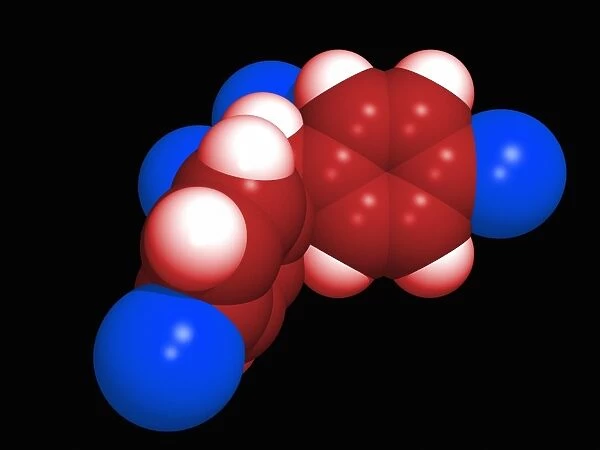Home > Arts > Portraits > Pop art gallery > Street art portraits
DDT molecule
![]()

Wall Art and Photo Gifts from Science Photo Library
DDT molecule
DDT molecule. Computer model of a molecule of the pesticide DDT (dichlorodiphenyltrichloroethane, C14. H9. Cl5). Atoms (spheres) are colour-coded: carbon (red), hydrogen (white), chlorine (blue). DDT attacks the central nervous system of insects. A synthetic pesticide, used since 1939, DDT and its products pollute the environment, taking decades to be broken down. It has been found to accumulate in animal fatty tissues, and so reach dangerous levels in the food chain. Although DDT use was banned in many countries in the 1970s, it is cheap to make and is still used in developing countries
Science Photo Library features Science and Medical images including photos and illustrations
Media ID 6275253
© DR TIM EVANS/SCIENCE PHOTO LIBRARY
Agricultural Compound Compounds Computer Farming Graphics Hydrocarbon Insecticide Models Molecular Graphic Molecules Organic Pesticide Poison Poisonous Pollutant Pollutants Pollution Space Filled Sphere Spheres Structural Toxic
FEATURES IN THESE COLLECTIONS
> Arts
> Portraits
> Pop art gallery
> Street art portraits
EDITORS COMMENTS
This print showcases a computer-generated model of the DDT molecule, a potent pesticide that has had a profound impact on our environment. The intricate structure of this compound is depicted with atoms represented as color-coded spheres: carbon in red, hydrogen in white, and chlorine in blue. DDT's significance lies in its ability to target the central nervous system of insects, making it an effective insecticide since its introduction in 1939. However, this synthetic chemical and its byproducts have caused widespread pollution and long-lasting environmental damage. It takes decades for DDT to break down naturally, leading to its accumulation in animal fatty tissues and subsequent entry into the food chain. Although many countries banned the use of DDT during the 1970s due to these harmful effects, it remains inexpensive to produce and continues to be utilized in developing nations today. This image serves as a reminder of the complex relationship between mankind's quest for agricultural productivity and the unintended consequences that can arise from such practices. Through this visually striking illustration created by Science Photo Library, we are confronted with both the beauty and danger inherent within chemical compounds like DDT. It encourages us to reflect on our responsibility towards sustainable farming practices while raising awareness about pollutants that persist within our ecosystems.
MADE IN THE UK
Safe Shipping with 30 Day Money Back Guarantee
FREE PERSONALISATION*
We are proud to offer a range of customisation features including Personalised Captions, Color Filters and Picture Zoom Tools
SECURE PAYMENTS
We happily accept a wide range of payment options so you can pay for the things you need in the way that is most convenient for you
* Options may vary by product and licensing agreement. Zoomed Pictures can be adjusted in the Basket.

